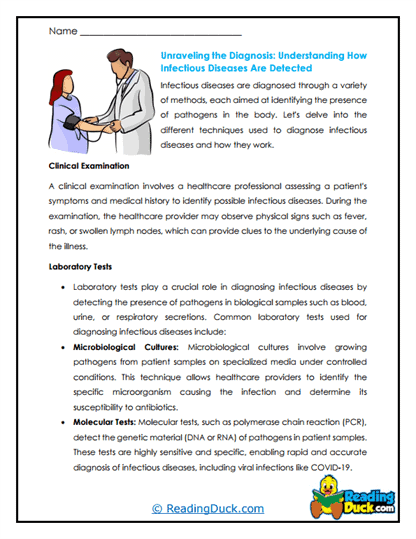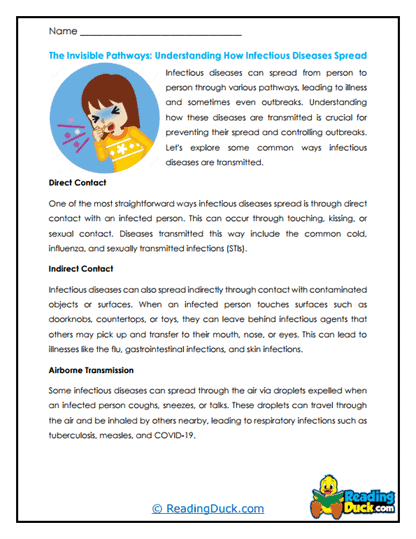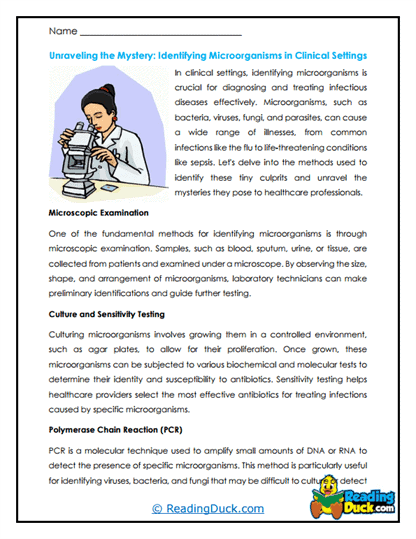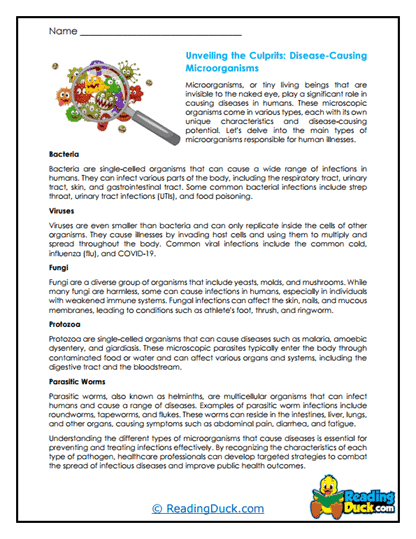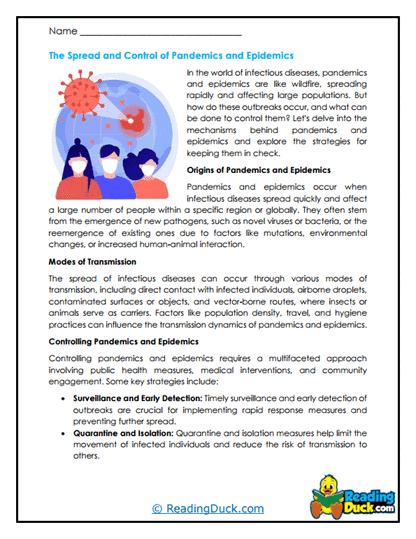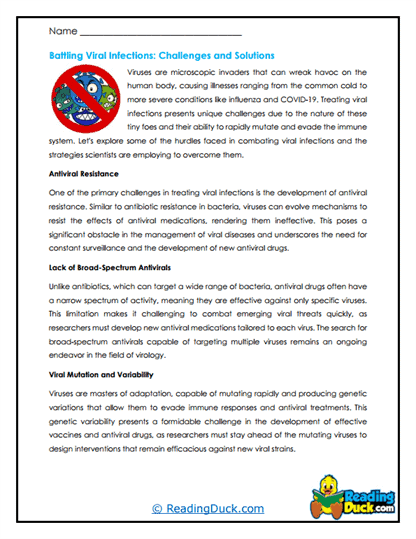Medical Microbiology Worksheets
About Our Medical Microbiology Worksheets
Our Medical Microbiology Worksheets offer an engaging and comprehensive exploration into the world of microorganisms that play a critical role in human health and disease. As a subtopic under the broader categories of Biology and Microbiology, this collection dives into the study of bacteria, viruses, fungi, and parasites that can cause infections and diseases in humans. These worksheets are designed to make learning about medical microbiology both educational and fascinating, providing students with a solid foundation in this essential field of science.
This collection contains several worksheet sets, each focusing on different aspects of medical microbiology. Each worksheet set includes:
- Multiple Choice Questions: These questions assess students' comprehension of the reading material, ensuring they grasp the key concepts and details presented.
- Short Answer Questions: This section encourages students to articulate their understanding in their own words, reinforcing their knowledge and improving their ability to communicate scientific information effectively.
- Open-Ended Questions: These questions invite students to share their personal thoughts, opinions, and reflections on the material, fostering deeper engagement and critical thinking.
An answer key is provided for every question sheet, making it easy for educators and parents to review students' work. All worksheets are available in PDF format, allowing them to be easily viewed electronically, downloaded, and printed for use in various educational settings.
Exploring Medical Microbiology: Understanding Pathogens and Their Impact
Medical microbiology is the branch of microbiology that focuses on the study of microorganisms responsible for causing diseases in humans. This field is vital for understanding how infections occur, how they spread, and how they can be prevented and treated. When introducing students to medical microbiology, it’s important to cover the diversity of pathogens, their mechanisms of infection, and the ways in which the human body responds to these threats. Here’s a detailed breakdown of the key aspects of medical microbiology covered in this collection:
Types of Pathogens: Medical microbiology deals with a variety of microorganisms, each with its own characteristics and modes of infection.
- Bacteria: Bacteria are single-celled organisms that can cause a wide range of infections, from strep throat to tuberculosis. Students will learn about the structure of bacteria, the differences between Gram-positive and Gram-negative bacteria, and how these distinctions affect treatment options.
- Viruses: Viruses are much smaller than bacteria and require a host cell to replicate. They are responsible for diseases such as the flu, HIV/AIDS, and COVID-19. Understanding how viruses invade cells and how the body defends against them is crucial for grasping the principles of virology and immunology.
- Fungi: Some fungi can cause infections, particularly in individuals with weakened immune systems. Students will explore common fungal infections like athlete’s foot, ringworm, and more serious conditions such as fungal pneumonia.
- Parasites: Parasites, including protozoa and helminths (worms), can cause diseases such as malaria and schistosomiasis. Understanding the life cycles of these organisms helps students comprehend how these diseases are transmitted and controlled.
Mechanisms of Infection and Disease: Understanding how pathogens cause disease is key to learning about medical microbiology.
- Infection Process: Students will learn about the stages of infection, including entry into the host, colonization, evasion of the immune system, and damage to the host tissues. This understanding is crucial for recognizing how infections develop and progress.
- Transmission of Diseases: Pathogens can be transmitted in various ways, including through direct contact, airborne particles, water and food, and vectors such as mosquitoes. Students will explore these transmission methods and their implications for public health.
- Virulence Factors: Certain features, known as virulence factors, enable pathogens to cause disease more effectively. These include toxins, enzymes that break down tissues, and mechanisms for avoiding the immune system. Learning about virulence factors helps students understand why some pathogens are more dangerous than others.
The Immune System’s Response to Infections: The immune system plays a critical role in defending the body against infections caused by pathogens.
- Innate Immunity: This is the body’s first line of defense, involving physical barriers like skin, as well as immune cells that recognize and respond to pathogens quickly. Students will learn how innate immunity provides immediate, non-specific defense against infections.
- Adaptive Immunity: Unlike innate immunity, adaptive immunity is highly specific and involves the activation of lymphocytes that “remember” past infections. Understanding adaptive immunity helps students appreciate how the body builds long-term immunity, which is the basis for vaccines.
- Vaccination: Vaccines prepare the immune system to fight infections by exposing it to a harmless version of the pathogen, thereby preventing future infections. Students will explore how vaccines work, their role in public health, and the ongoing challenges in vaccine development.
Diagnosis and Treatment of Infectious Diseases: Accurate diagnosis and effective treatment are essential for managing infectious diseases.
- Diagnostic Techniques: Students will learn about various methods used to diagnose infections, including culture techniques, serological tests, and molecular methods like PCR. Understanding these techniques is important for recognizing how infections are identified and monitored.
- Antibiotics and Antimicrobial Agents: Antibiotics are used to treat bacterial infections, while antiviral, antifungal, and antiparasitic drugs are used to treat other types of infections. Students will explore how these drugs work, the importance of selecting the right treatment, and the growing issue of antimicrobial resistance.
- Antimicrobial Resistance: The misuse and overuse of antimicrobial drugs have led to the development of resistant strains of pathogens. Understanding this problem helps students appreciate the importance of responsible drug use and the need for new treatments.
Public Health and Epidemiology: Medical microbiology plays a crucial role in public health and the control of infectious diseases.
- Epidemiology: Epidemiology is the study of how diseases spread and affect populations. Students will learn about the principles of epidemiology, including the identification of outbreaks, tracking the spread of diseases, and implementing measures to control them.
- Preventative Measures: Preventing the spread of infections is a key aspect of public health. Students will explore strategies such as sanitation, vaccination, vector control, and public education, and understand how these measures contribute to the control of infectious diseases.
- Global Health Challenges: Infectious diseases remain a major challenge in global health, particularly in developing countries. Students will learn about the impact of diseases like malaria, HIV/AIDS, and tuberculosis on global health and the efforts being made to combat these diseases.
By studying these aspects of medical microbiology, students gain a comprehensive understanding of how microorganisms cause disease, how the body fights infections, and how modern medicine diagnoses and treats these conditions. The worksheets help break down complex concepts into engaging and accessible material, fostering curiosity and a deeper appreciation for the role of microbiology in human health.
How to Supplement These Worksheets
Here are four creative ideas on how teachers and parents can use these Medical Microbiology Worksheets in school or in a homeschool setup:
- Infectious Disease Case Studies: Assign students to research and present case studies of specific infectious diseases, such as tuberculosis, malaria, or influenza. Using the worksheets as a guide, students can explore the pathogen involved, the symptoms, the mode of transmission, and the treatment options. This activity helps students apply their knowledge in real-world scenarios and develop a deeper understanding of the impact of infectious diseases on individuals and communities.
- Microbial Culture Experiment: Encourage students to culture bacteria from various sources (e.g., doorknobs, hands, or soil) on nutrient agar plates. They can document the growth, identify different types of colonies, and use the worksheets to analyze the results. This hands-on experiment reinforces concepts related to bacterial growth, diagnostic techniques, and the diversity of microorganisms.
- Role-Playing a Pandemic Response: Organize a role-playing activity where students take on the roles of epidemiologists, public health officials, and healthcare workers responding to an outbreak. Using the worksheets, they can plan and implement strategies to control the spread of the disease, such as vaccination campaigns, quarantine measures, and public education. This activity promotes teamwork, critical thinking, and a practical understanding of public health measures.
- Debate on Antimicrobial Resistance: Hold a classroom debate on the issue of antimicrobial resistance. Students can be divided into teams to argue the causes, consequences, and potential solutions to this global health challenge. The worksheets can provide background information and help students formulate their arguments. This activity develops critical thinking and communication skills while emphasizing the importance of responsible antimicrobial use.
The Importance of Learning About Medical Microbiology
Understanding medical microbiology is crucial for students on both an academic and personal level. Academically, it provides a foundation for advanced studies in biology, medicine, public health, and epidemiology. It also enhances critical thinking skills as students explore the complexities of infectious diseases, the mechanisms of pathogens, and the development of treatments and vaccines.
On a personal level, knowledge of medical microbiology empowers students to make informed decisions about their health and the health of others. Understanding how infections spread, the importance of hygiene, vaccination, and the risks associated with antimicrobial resistance helps students take an active role in their own well-being. This awareness can lead to healthier lifestyle choices and a better understanding of how to protect themselves and their communities from infectious diseases.
Overall, these Medical Microbiology Worksheets offer a valuable resource for educators and students alike, providing a detailed and engaging exploration of one of the most critical fields in modern science. Through these activities, students can deepen their understanding of medical microbiology and develop a greater appreciation for the role it plays in protecting and improving human health.
